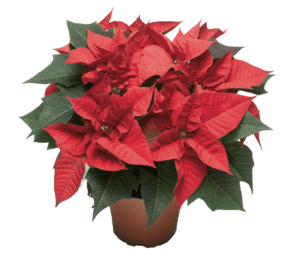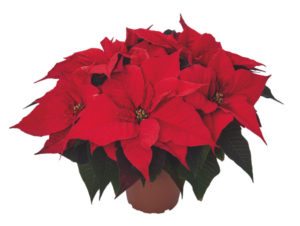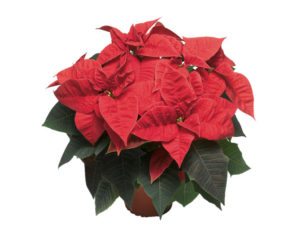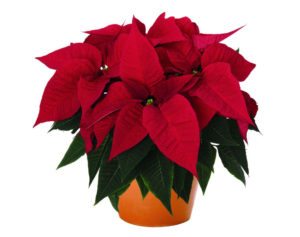
New Poinsettia Cultivar Performance
Poinsettia breeding companies have released dozens of new cultivars in the past few years. A frequent comment heard at this year’s trials was that there are many good cultivars and very few “bad ones.” The breeders have learned how to develop excellent cultivars with strong structure and improved bract presentations. The National Poinsettia Trials conducted at North Carolina State University and the University of Florida are aimed at giving growers an early independent evaluation of the new cultivars that are being introduced each year.
The pace of new cultivar introductions slowed for 2017. Only six cultivars are being introduced this year that were tested in both the NCSU and UF 2016 trials. All the companies now have good genetics, and the industry will benefit from more thorough evaluations before new cultivars are introduced.
Red
‘Aria Red’ (Syngenta). This is an attractive cultivar suited for smaller size formats. The bright red bracts are smaller than average and held upright on top of the plant. Centers are smaller than average. Branching is very good and habit is a wide V shape. Plants have low to medium vigor. Compared to ‘Titan Red’, the plants are shorter and fuller with more leaves and bracts. Although described as an early season cultivar, plants flowered midseason at both trial locations. ‘Aria Red’ will likely be most useful in 61⁄2-inch or smaller pots or other formats needing a short attractive plant.
‘Bouquet’ (Dümmen Orange). The name is designed to evoke the image of a bouquet of flowers — plants are upright with a narrow base and numerous bract clusters at the top. Bracts are brighter red than either ‘Premium Red’ or ‘Prestige Red’, medium sized and slightly elongated. Centers are tight with distinct cyathia. Stem thickness and strength are similar to ‘Prestige Red’ and Premium. ‘Bouquet’ finishes at eight weeks and is similar in vigor to ‘Prestige Red’. ‘Bouquet’ has the potential to be an important cultivar because of its attractive appearance combined with the upright habit. It can be used in a range of pot sizes.
‘Grande Italia’ (Dümmen Orange). This new cultivar can be used to produce a plant that makes a statement. The plant has large leaves and big smooth bracts that are held on top of the plant. Stem strength and plant habit are similar to ‘Prestige Red’, except that ‘Grande Italia’ is taller. It may be more vigorous than the average cultivar, but height should be easy to control. Finish timing is midseason (eight and a half weeks). ‘Grande Italia’ may become an important cultivar for use in larger formats.
‘Majoris Red’ (Syngenta). ‘Majoris Red’ has potential to be a larger plant with medium or slightly greater vigor. The plants have strong stems and slightly wide growth habit that benefits from using rings. Branching is good and the plant produces enough shoots to fill out larger pots. The medium sized bracts are bright red and presented on top of the plant. Majoris flowered midseason at NCSU under natural days and in seven and a half weeks with photoperiod control in the Florida trial. Compared to ‘Titan Red’, which also is fairly vigorous, ‘Majoris Red’ will produce a fuller appearance and size will be easier to control. ‘Majoris Red’ has the characteristics to make very nice plants in 6-inch and larger sizes. It should work also in 41⁄2-inch products with appropriate adjustments to schedules and growth regulator use.
‘Southern Belle’ (Dümmen Orange). The bright red bracts are held upright on top of the plants. Bract and leaf size is medium to slightly small. Plant habit and stem strength is close to ‘Prestige Red’, and vigor was similar to ‘Premium Red’ in Florida but greater than ‘Premium Red’ in North Carolina. However, with the smaller bract size the plants appeared to be smaller than Premium or Prestige. ‘Southern Belle’ is well named in that it is supposed to perform well in high temperatures. Finish timing is midseason to slightly later, depending on the location. ‘Southern Belle’ makes an attractive plant and should be useful in a range of pot sizes.
Novelty
‘Peppermint Ruffles 2017’ (Dümmen Orange). This cultivar is a significant improvement on the original ‘Peppermint Ruffles’ with a much more distinctive “peppermint” coloring. The rounded bracts on the 2017 selection are slightly less ruffled than the previous selection. The new selection is also earlier flowering (seven and a half weeks response time). The growth habit is still a wide, rounded plant that benefits from support in 61⁄2-inch pots. ‘Peppermint Ruffles 2017’, as before, is a high vigor cultivar; however, the new selection is a stronger plant. This cultivar would be good for growers selling to markets that have strong demand for novelties.








 Video Library
Video Library 




















